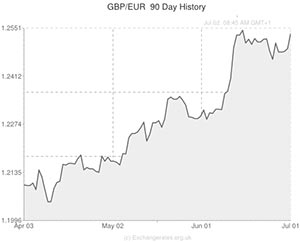
The Pound posted sizable gains against most of its major currency rivals yesterday as new manufacturing data added to speculation that the Bank of England will start to raise interest rates before the end of the year.
Sterling exchange rate
Sterling broke through resistance at 1.25 against the Euro yesterday, rising by around 0.4 cents. GBP to Euro is now within reach of the 20-month high that was struck on June 16th.
The Pound powered its way to a fresh 5.5-year high above 1.71 against the US Dollar (GBP/USD) and the Sterling to Canadian Dollar exchange rate (GBP/CAD) appreciated by around a quarter of a cent to a fresh weekly high just below 1.83.
‘March of the makers’
Back in his 2011 budget Chancellor of the Exchequer George Osborne called for a ‘march of the makers’ to drive the British economy forward with vigorous manufacturing activity. To all intents and purposes his call has not been answered yet: manufacturing output is still over 7% lower than it was before the crisis even though British GDP is thought to have returned to pre-crisis levels during the second quarter of this year.
Having said that, the manufacturing sector as measured by the Purchasing Managers Index has posted solid growth (a score above 50.0) in each of the last 13 months.
And last month’s report had a lot of things for the Chancellor to get excited about: the headline index rose from 57.0 to a 7-month high of 57.5, defying expectations for a deceleration to 56.8; the new orders index reached its highest rate since last November; and the job creation index signalled that firms are hiring at their fastest pace since March 2011.
The upbeat report boosted demand for the Pound as traders estimated that second quarter Gross Domestic Product could print north of 1.0%. In light of recent comments from Bank of England Governor Mark Carney it is now looking increasingly likely that the central bank will begin its tightening cycle in November.
Although Osborne’s ‘march of the makers’ is still some way off coming to fruition, the latest positive development will make it a lot easier for policymakers at the BoE to argue the case for a rise in interest rates. This is because the initial revival in the UK economy appeared to be largely fuelled by rising house prices and precipitous household spending. Now however Britain looks to be on course for sturdy growth across all areas of the economy, therefore making it more capable of coping with a rise in borrowing costs.

Comments are closed.